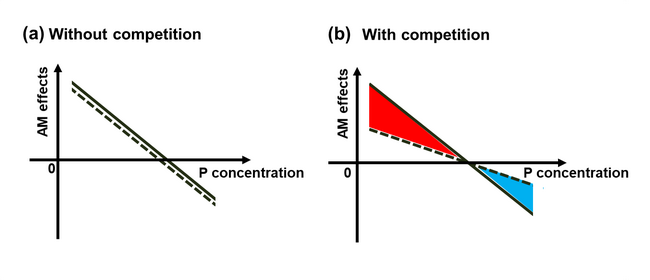Prof. Shaolin Peng’s Group in School of Life Sciences identified arbuscular mycorrhizal facilitation on plant invasion is nutrient dependent
Source: School of Life Sciences
Written by: School of Life Sciences
Edited by: Xu Jia, Wang Dongmei
Recently, a research article entitled “Arbuscular mycorrhizal fungi are a double-edged sword in plant invasion controlled by phosphorus concentration” has been published online in
New Phytologist (IF5Y=8.344). This study highlights that the promoting effects of arbuscular mycorrhizal (AM) fungi on the plant invasion is soil phosphorus (P) concentration dependence. Prof. Shaolin Peng from the School of Life Sciences at Sun Yat-sen University is the corresponding author, and PhD student Enjian Chen is the first author.

Figure: A hypothetical conceptual model of the differential arbuscular mycorrhizal (AM) effects on the competition between native and invasive plants affected by phosphorus (P) concentration. An increase in P shifts the AM effects on native (dashed line) and invasive (solid line) plants from positive to negative (a). With competition (b), lower AM colonization on native plants weakens the AM effects on the native but not the invasive plants. Invasive plants experience more positive AM effects (red area) under low-P concentrations, but more negative AM effects (blue area) under high-P concentrations than native plants.
The invasion success of some exotic plants depends on the associations with arbuscular mycorrhizal fungi, which range along a continuum from strong mutualism to parasitism frequently affected by soil phosphorus availability. It is unclear how P availability shifts AM associations on native and invasive plants, which in turn influence their competition. In this work, a three-factor common garden experiment was conducted, including manipulations of P availability, AM fungi occurrence and interspecific competition to evaluate how AM fungi influence competition between two pairs of invasive and native plants under different P availabilities. The results showed that P enrichment reduced positive AM effects on the growth of both native and invasive plants (Figure a). Competition had no effect on AM colonization on the invasive plants, but reduced AM colonization on the native plants, which led invasive plants to receive greater AM benefits under low-P concentrations, but expose to stronger AM detriments under high-P concentrations compared to the native competitors (Figure b). Therefore, the competitive advantage of invasive vs native plants was enhanced by AM fungi under low-P concentrations, but weakened under high-P concentrations.
This work proposes a new idea of controlling alien plant invasion by changing the symbiotic relationship between soil microorganisms and plants, and predicts that the promoting effects of AM fungi on plant invasion will be further increased for a greater shortage of P under nitrogen deposition.
This work was supported by the National Natural Science Foundation of China (NSFC 31700450, NSFC 31971556), Special Funds of Guangdong Province for Promoting Economic Development (For the Development of Marine Economy, GDME⁃2018E002), Vegegraphy of China (2015FY210200-13), Zhang Hongda Science Foundation and Fu Jia-Rui Scholarship in Sun Yat-sen University
Link to the paper:
https://doi.org/10.1111/nph.16359
